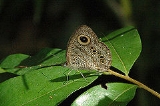
Ypthima baldus
Encyclopedia

Satyrinae
Satyrinae, the satyrines or satyrids, commonly known as the Browns, is a subfamily of the Nymphalidae . They were formerly considered a distinct family, Satyridae. This group contains nearly half of the known diversity of brush-footed butterflies...
butterfly found in Asia
Asia
Asia is the world's largest and most populous continent, located primarily in the eastern and northern hemispheres. It covers 8.7% of the Earth's total surface area and with approximately 3.879 billion people, it hosts 60% of the world's current human population...
.
Wet-season form
_i_img_9504.jpg)
Underside similar to the underside in Y. philomela but the ochraceous-white ground-colour paler, tin-transverse brown strice coarser, the ocelli on the hind wing more distinctly in echelon, two tornal, two median, and two pre-apical, and on both fore and hind wing more or less distinctly defined, subbasal, discal and subterminal brown transverse bands.
Female: Differs on the upperside in having the area surrounding or bordering the ocelli on both fore and hind wing paler, closely irrorated with brown striae, the discal transverse band generally clearly defined, and very often both the tornal, and at least one of the apical, ocelli distinct. On the underside it is paler than the male, and has the subbasal, discal and subterminal transverse dark bands more clearly defined.
Dry-season form
_on_mikania_micrantha_(bittervine,_mile-a-minute,_american_rope,_chinese_creeper)_in_kolkata_w_img_3727.jpg)
-_dry_season_form_in_kolkata_w_img_3738_.jpg)
Wing expanse of 38-46 mm.

